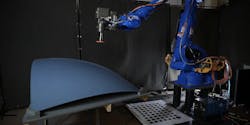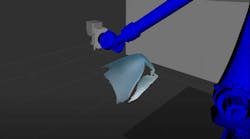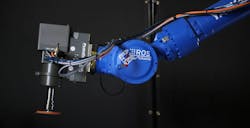Newly-Developed Robotics Imaging Tool Automates Aircraft Surface Prep
Southwest Research Institute (SwRI) has introduced a new type of automation tech that enables industrial robots to visually classify work and then automatically perform those tasks. These tasks can be grinding, painting, polishing, cleaning, welding, sealing, and more.
“Our solutions increase process repeatability while improving part quality and decreasing rework. They also reduce human exposure to dangerous environments,” said Matt Robinson, a robotics R&D manager at SwRI.
SwRI uses its own machine learning algorithms and classification software which is able to work with open-source tools such as Scan-N-Plan and ROS 2, the latest version of the open-source robot operating system.
Traditional robot programming brings its own set of challenges like requiring expert knowledge and taking a lot of extra time. Another way to program is to use Scan-N-Plan, an ROS-Industrial technology that uses machine vision to scan parts to create 3D mesh data for the robots to use to plan tool paths and trajectories—all while performing real-time process monitoring.
“By leveraging these open-source tools with our custom software, we have developed a solution that intelligently classifies regions and textures of part surfaces in various stages of work,” Robinson said.
SwRI says the solution includes custom machine vision algorithms that enable robots to apply many different types of media with varying pressure based on the amount of surface work needed. Feature-based processing is also enabled through additions that leverage semantic segmentation approaches to apply the right tool to the right feature—such as cutting versus sanding.
“These are breakthroughs that will help prevent robots from over-sanding or over-grinding metal surfaces,” said Paul Evans, director of SwRI’s Manufacturing Technologies Department.
This project demonstrates the advanced features of ROS 2 while providing an initial framework for additional application build-out. It's also an open-source example for teaching and training those interested in developing advanced solutions that leverage ROS.
“SwRI is excited to be providing proven solutions that leverage this framework to the commercial and government industrial client base, across a broad array of applications, for both stationary cell-based systems and mobile solutions,” added Robinson.
An onboard camera overlays the map to create a colorized mesh to facilitate advanced processing. The combination of 2D, 3D, and color classification drives more intelligent processing. This new capability will be made available via the ROS-Industrial open-source program.


